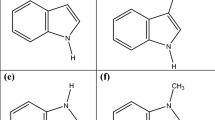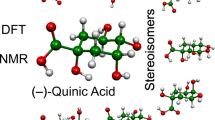Abstract
The study is concerned with analysis of the energies of formation (E), frequency shifts (Δν) in IR spectra, ionization potentials (IP) of H-complexes, hydrogen bond lengths (r), and spin densities (sd) in H-complexes involving radical cations, obtained from quantum chemical calculations for 20 series of H-complexes. It was for the first time established that the E, IP, r, and sd values and the changes in enthalpy (δH) depend not only on the inductive and resonance effects but also on the polarizability effect of the substituents bound to the donor and acceptor centers in the H-complexes. Interrelations between the polarizability effect and the molecular structure of H-complexes are considered.
Similar content being viewed by others
References
M. D. Joesten and L. J. Schaad, Hydrogen Bonding, Marcel Dekker, New York, 1974.
Vodorodnaya svyaz’ [The Hydrogen Bond], Ed. N. D. Sokolov, Nauka, Moscow, 1981, 288 pp. (in Russian).
C. L. Perrin and J. B. Nielson, Ann. Rev. Phys. Chem., 1997, 48, 511.
C. Hansch, A. Leo, and R. W. Taft, Chem. Rev., 1991, 91, 165.
A. N. Egorochkin and M. G. Voronkov, Elektronnoe stroenie organicheskikh soedinenii kremniya, germaniya i olova [Electronic Structure of Organosilicon, Organogermanium, and Organotin Compounds], Izd. SO RAN, Novosibirsk, 2000, 615 pp. (in Russian).
P. D. Pacey and Q.-T. Tan, J. Phys. Chem., 1995, 99, 17729.
A. N. Egorochkin and O. V. Kuznetsova, Izv. Akad. Nauk. Ser. Khim., 2002, 881 [Russ. Chem. Bull., Int. Ed., 2002, 51, 961].
B. Galabov and P. Bobadova-Parvanova, J. Phys. Chem. A, 1999, 103, 6793.
V. Dimitrova, S. Ilieva, and B. Galabov, J. Phys. Chem. A, 2002, 106, 11801.
Y. Fang, L. Liu, Y. Feng, X.-S. Li, and Q.-X. Guo, J. Phys. Chem. A, 2002, 106, 4669.
A. K. Chandra and T. Zeegers-Huyskens, J. Org. Chem., 2003, 68, 3618.
S. Wojtulewski and S. J. Grabowski, J. Mol. Struct., 2002, 605, 235.
Y. Feng, L. Liu, Y. Fang, and Q.-X. Guo, J. Phys. Chem. A, 2002, 106, 11518.
S.-I. Kawahara and T. Uchimaru, J. Mol. Struct., THEOCHEM, 2002, 588, 29.
G. I. Sarapulova, D.Sc. (Chem.) Thesis, A. E. Favorsky Institute of Chemistry, Siberian Branch of the Russian Academy of Sciences, Irkutsk, 2004, 261 pp. (in Russian).
A. N. Egorochkin, M. G. Voronkov, O. V. Zderenova, and S. E. Skobeleva, Izv. Akad. Nauk. Ser. Khim., 2001, 41 [Russ. Chem. Bull., Int. Ed., 2001, 50 43].
Author information
Authors and Affiliations
Additional information
Published in Russian in Izvestiya Akademii Nauk. Seriya Khimicheskaya, No. 4, pp. 602–608, April, 2006.
Rights and permissions
About this article
Cite this article
Kuznetsova, O.V., Egorochkin, A.N. Correlation analysis of quantum chemical data and the polarizability effect in H-complexes. Russ Chem Bull 55, 624–631 (2006). https://doi.org/10.1007/s11172-006-0303-2
Received:
Issue Date:
DOI: https://doi.org/10.1007/s11172-006-0303-2




